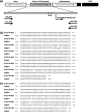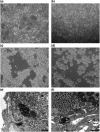Enhancement of enteric adenovirus cultivation by viral transactivator proteins
- PMID: 20139315
- PMCID: PMC2849201
- DOI: 10.1128/AEM.02224-09
Enhancement of enteric adenovirus cultivation by viral transactivator proteins
Abstract
Human enteric adenoviruses (HAdVs; serotypes 40 and 41) are important waterborne and food-borne pathogens. However, HAdVs are fastidious, are difficult to cultivate, and do not produce a clear cytopathic effect during cell culture within a reasonable time. Thus, we examined whether the viral transactivator proteins cytomegalovirus (CMV) IE1 and hepatitis B virus (HBV) X promoted the multiplication of HAdVs. Additionally, we constructed a new 293 cell line expressing CMV IE1 protein for cultivation assays. We analyzed the nucleic acid sequences of the promoter regions of both E1A and hexon genes, which are considered to be the most important regions for HAdV replication. Expression of either HBV X or CMV IE1 protein significantly increased the promoter activities of E1A and hexon genes of HAdVs by as much as 14-fold during cell cultivation. The promotion of HAdV expression was confirmed by increased levels of both adenoviral DNA and mRNA expression. Finally, the newly developed 293 cell line expressing CMV IE1 protein showed an increase in viral DNA ranging from 574% to 619% compared with the conventional 293 cell line. These results suggest that the newly constructed cell line could be useful for efficient cultivation and research of fastidious HAdVs.
Figures






Similar articles
-
Field evaluation of an improved cell line for the detection of human adenoviruses in environmental samples.J Virol Methods. 2014 Sep 1;205:68-74. doi: 10.1016/j.jviromet.2014.05.002. Epub 2014 May 10. J Virol Methods. 2014. PMID: 24821079
-
Disruption of PML-associated nuclear bodies by IE1 correlates with efficient early stages of viral gene expression and DNA replication in human cytomegalovirus infection.Virology. 2000 Aug 15;274(1):39-55. doi: 10.1006/viro.2000.0448. Virology. 2000. PMID: 10936087
-
Enhancement of enteric adenovirus cultivation in a novel Ras-overexpressing cell line.J Gen Virol. 2014 Jan;95(Pt 1):171-178. doi: 10.1099/vir.0.055608-0. Epub 2013 Oct 4. J Gen Virol. 2014. PMID: 24096320
-
The acidic activation domain of the baculovirus transactivator IE1 contains a virus-specific domain essential for DNA replication.J Virol. 2002 Jun;76(11):5598-604. doi: 10.1128/jvi.76.11.5598-5604.2002. J Virol. 2002. PMID: 11991988 Free PMC article.
-
Regulation of adenovirus mRNA formation.Adv Virus Res. 1986;31:169-228. doi: 10.1016/s0065-3527(08)60264-x. Adv Virus Res. 1986. PMID: 3529876 Review. No abstract available.
Cited by
-
Elution Is a Critical Step for Recovering Human Adenovirus 40 from Tap Water and Surface Water by Cross-Flow Ultrafiltration.Appl Environ Microbiol. 2016 Jul 29;82(16):4982-93. doi: 10.1128/AEM.00870-16. Print 2016 Aug 15. Appl Environ Microbiol. 2016. PMID: 27287319 Free PMC article.
-
Proteomic analysis of A-549 cells infected with human adenovirus 40 by LC-MS.Virus Genes. 2018 Jun;54(3):351-360. doi: 10.1007/s11262-018-1554-3. Epub 2018 Mar 15. Virus Genes. 2018. PMID: 29546667
-
Diagnosis of Pediatric Acute Adenovirus Infections: Is a Positive PCR Sufficient?Pediatr Infect Dis J. 2016 Aug;35(8):827-34. doi: 10.1097/INF.0000000000001119. Pediatr Infect Dis J. 2016. PMID: 26974888 Free PMC article.
-
Advances in understanding interferon-mediated immune responses to enteric viruses in intestinal organoids.Front Immunol. 2022 Jul 22;13:943334. doi: 10.3389/fimmu.2022.943334. eCollection 2022. Front Immunol. 2022. PMID: 35935957 Free PMC article. Review.
-
Circulation of HAdV-41 with diverse genome types and recombination in acute gastroenteritis among children in Shanghai.Sci Rep. 2017 Jun 14;7(1):3548. doi: 10.1038/s41598-017-01293-3. Sci Rep. 2017. PMID: 28615624 Free PMC article.
References
-
- Biegalke, B. J., and A. P. Geballe. 1991. Sequence requirements for activation of the HIV-1 LTR by human cytomegalovirus. Virology 183:381-385. - PubMed
-
- Chapron, C. D., N. A. Ballester, J. H. Fontaine, C. N. Frades, and A. B. Margolin. 2000. Detection of astroviruses, enteroviruses, and adenovirus types 40 and 41 in surface waters collected and evaluated by the information collection rule and an integrated cell culture-nested PCR procedure. Appl. Environ. Microbiol. 66:2520-2525. - PMC - PubMed
Publication types
MeSH terms
Substances
LinkOut - more resources
Full Text Sources

